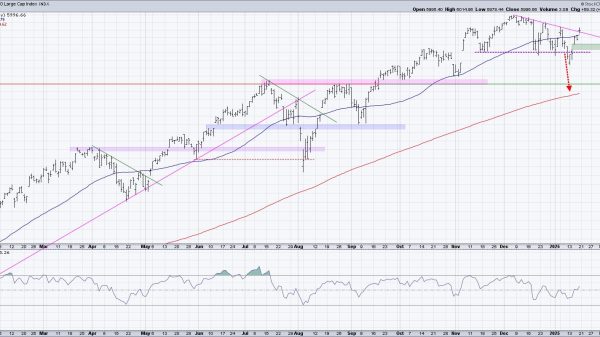America’s federally sanctioned entitlement programs, Medicare, Medicaid, and Social Security, each face bankruptcy in the next few years. Medicare and Medicaid were created in 1965 as part of President Lyndon Johnson’s Great Society legislation. Social Security was created in 1935 to provide retirement income for Americans who reached the age of sixty-five. These three entitlement programs consume about fifty cents of every federal budget dollar, or $2.7 trillion in fiscal year 2023.
Medicare is a federal health-insurance and healthcare program available for enrollment when a person reaches the age of sixty-five. An American who has worked for a minimum of ten years is eligible for enrollment. Employees and employers each pay a minimum Medicare tax of 1.45 percent based on the employees’ wages. Once enrolled in the program, one pays a monthly insurance premium that changes every year. Sixty-five million people are enrolled as of 2022. There is a penalty for late enrollment. The amount of people on Medicare is roughly equal to the estimated state populations of Florida, New York, Pennsylvania, and Illinois combined.
Medicare made net benefit payments of $689 billion in 2021. It comprised 20 percent of national healthcare spending and 12 percent of the federal budget in 2020. Medicare covers about 80 percent of medical costs, but dental and eye procedures are not covered.
Medicaid is a joint federal and state program that, together with the Children’s Health Insurance Program (CHIP), provides health coverage to over 72.5 million Americans, including children, pregnant women, parents, seniors, and individuals with disabilities. Medicaid is the single largest source of health coverage in the United States. Most participants are under the age of sixty-five. The amount of people on Medicaid is roughly equal to the estimated state populations of California and Texas combined.
For a state to participate in Medicaid, federal law requires that state to cover certain groups of individuals. Qualifying low-income families children and pregnant women, and individuals receiving Supplemental Security Income (SSI) are examples of mandatory eligibility groups. The Affordable Care Act of March 2010 (Obamacare) created the opportunity for states to expand Medicaid to cover nearly all low-income Americans under age sixty-five. Roughly twelve million people signed up after 2010.
Medicaid’s costs are swamping state budgets, climbing from 9 percent in 1989 to 20 percent today. A majority of its funding is from every American taxpayer, and a minority of funding is from each participating state’s taxpayer. Medicaid payments were $117 billion in 2000 and $589 billion in 2023. They are projected to be $879 billion in 2033.
Social Security is one of the largest government programs in the world as of 2023, paying out hundreds of billions of dollars each year. In 2021, 179 million people paid taxes into Social Security. The current tax rate for Social Security is 6.2 percent for the employer and employee each, or 12.4 percent total from the employee’s wages.
Sixty-seven million Americans will receive Social Security in 2023. The estimated combined populations of the US states of Ohio, Georgia, North Carolina, Michigan, New Jersey, and Virginia will be equivalent to the amount of Americans on Social Security as of 2023. Social Security provides retirement benefits and disability income to qualified people and their spouses, children, and survivors. Workers must be at least sixty-two years old and have paid taxes into Social Security over a minimum of ten years to qualify for its benefits.
The adult lifespan was about fifty-eight years in 1930 and seventy-nine years in 2020. The number of workers paying payroll taxes was about five for every beneficiary in 1960 compared to about 2.7 for every beneficiary in 2023. America’s population is aging and its families are having fewer children. This poses a problem for Social Security funding.
Some Americans are receiving Medicare and Social Security benefits at the same time: as we say in America, they are double-dipping.
Bankruptcy Reality
A Government Accountability Office (GAO) report from 2015 revealed that $60 billion of Medicare’s budget was lost in 2014 to waste. The GAO found 23,400 fake or bad addresses on Medicare’s list of providers.
Medicare has repeatedly suffered vast cost overruns, has been reformed countless times, and has imposed a seemingly endless series of price controls on doctors and hospitals. Price controls reduce competition from the free market, leading to less efficiency and higher prices.
The Medicare board of trustees projected that the reserves of the Hospital Insurance (HI) Trust Fund, which finances Medicare Part A, will be depleted in 2031. The program’s income will be able to cover 89 percent of scheduled benefits after that. How will hospitals and physicians handle an 11 percent shortfall in Medicare reimbursement payments?
Public literature on the future bankruptcy of the Medicaid program is near nil, so predicting a date for bankruptcy is not possible. However, the Social Security board of trustees in its 2023 report forecasts reserves in the Old-Age and Survivors Insurance (OASI) Trust Fund will be depleted in 2033. Ongoing tax revenue will be enough to pay 77 percent of scheduled benefits after that point. Beneficiaries in that year will see their monthly payment reduced by 23 percent. Many American retirees today rely solely on Social Security to pay groceries, home insurance premiums, and utilities. Could you survive a 23 percent reduction in your income year over year?
Possible Solutions
America entitlement programs will not become bankrupt overnight but over many decades. Reforms will not solve this problem quickly, but they would be steps toward a more sustainable situation. Some possible reforms to Medicare and Social Security are to allow taxpayers under the age of forty-five to renounce future benefits with no federal tax impact and to live on their 401(k), Roth IRA, or other income, considering all their past tax payments lost. Another option is to allow such people renounce their benefits and to redirect their future tax payments to separate 401(k)-type retiree healthcare and retirement accounts under their oversight. Current and future Medicare and Social Security beneficiaries could also opt to receive reduced benefits based on financial realities before or after the programs’ bankruptcies.
Ryan McMaken, executive editor at the Mises Institute, penned a Mises Wire article in January 2023 titled “Raise the Social Security Age to (at Least) 75,” posing possible reforms. George Reisman penned a lengthy Mises Wire article in April 2011 titled “How to Eliminate Social Security and Medicare” with more detailed solutions.
Medicaid reforms that address fraud are being pursued by many states and the federal government. Some methods of Medicaid fraud are found on the Centers for Medicaid and Medicare Services’ fraud checklist. The current list of people subject to federal enforcement actions can be found on the Office of Inspector General’s website. The enforcement actions shown have yielded fines tied to a fraud conviction.
A one-size-fits-all reform is not possible. Some say to abolish each program right now and let the free market provide guidance out of the chaos. But the logistics of caring for an aging and ailing family member are not easy even when the family is prepared financially, physically, and spiritually. The reality of federal entitlement reform is before us, and the everyday people will bear the brunt of these entitlement programs’ bankruptcies.























